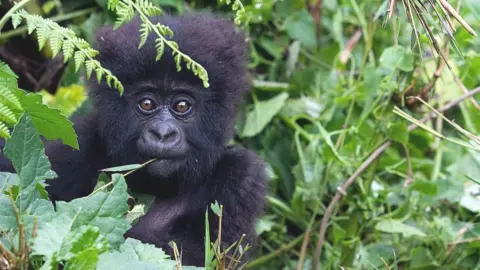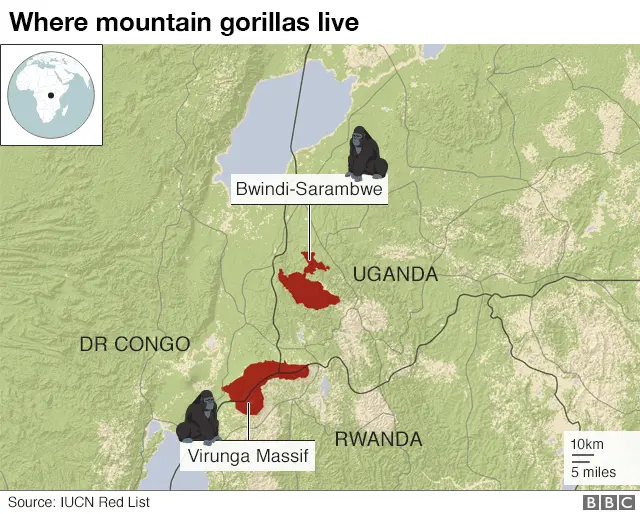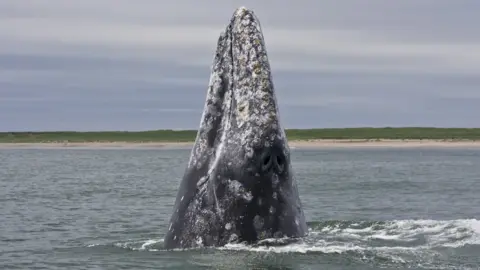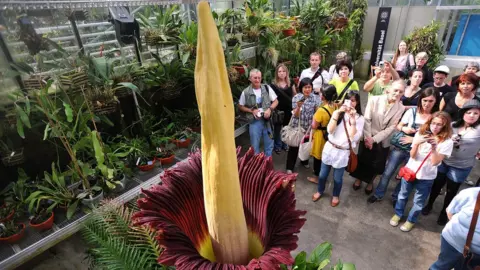'Conservation successes' bring hope for mountain gorilla
 Getty Images
Getty ImagesConservation efforts appear to be paying off for some of the world's most charismatic animals, according to new assessments for the extinction Red List.
Prospects look better for the mountain gorilla, after years of conservation measures, including anti-poaching and veterinary patrols.
And numbers of two large whales are recovering, following hunting bans.
However, other flora and fauna is declining.
Species getting closer to extinction include several types of fish, a globally important timber tree, and one of the world's largest and smelliest flowers.
The fin whale, western gray whale, mountain gorilla and Rothschild's giraffe are among the animals where numbers are rising.
The latest assessments by the International Union for Conservation of Nature - IUCN come as governments convene in Egypt for the Convention on Biological Diversity.
IUCN Director General, Inger Andersen, said the recoveries we are seeing illustrate the power of conservation action.
"These conservation successes are proof that the ambitious, collaborative efforts of governments, business and civil society could turn back the tide of species loss," she said.
Almost 100,000 plants and animals have now been evaluated for extinction threats by the IUCN. Of these, around a quarter are on the edge of extinction.
The "winners" in the new Red List include:
The mountain gorilla
There were around 600 mountain gorillas left in the wild in 2008; but numbers have now risen to over 1,000 after intensive conservation efforts. These include anti-poaching patrols and vets trained to give care to gorillas in the wild.

The gorilla is restricted to protected areas in the Democratic Republic of the Congo, Rwanda and Uganda. Threats remain, including poaching, civil unrest and diseases passed on by humans.
But while mountain gorillas are increasing in number, the great ape remains endangered.
Dr Liz Williamson of the IUCN primate specialist group said conservation action must continue.
"Coordinated efforts through a regional action plan and fully implementing IUCN Best Practice guidelines for great ape tourism and disease prevention, which recommend limiting numbers of tourists and preventing any close contact with humans, are critical to ensuring a future for the mountain gorilla," she said.
 Getty Images
Getty ImagesThe fin whale
Populations of this large whale - one of the biggest in the ocean - are on the rise, and have roughly doubled since the 1970s. There are now estimated to be 100,000 adults.
The western gray whale
This whale too is reaping the benefits of bans on commercial whaling. Numbers are starting to rise, albeit more slowly. However, this success could be derailed by threats from oil and gas development and commercial fisheries.
 Oregon State University
Oregon State UniversityRandall Reeves of the IUCN cetacean specialist group said it is a relief to see populations of both whales on the rise, but conservation efforts must continue.
He told BBC News: "Large whales are, for the most part, doing pretty well - they show that if you stop killing them, they can recover. Not all populations of large whales are recovering - some of them were brought so low that they still may disappear."
The "losers" in the new Red List include:
The titan arum
 Getty Images
Getty ImagesNicknamed the corpse flower, one of the world's largest and smelliest flowers has been assessed for the first time. It is found in the wild only on the island of Sumatra, Indonesia. Only about 1,000 plants remain in the wild. It is under threat from logging and the clearing of forest for oil palm plantations.
The vene tree
Illegal logging is threatening the survival of this globally important timber tree, found in West and Central Africa.
 Marco Schmidt
Marco SchmidtFish
Fifty-four fish species from two important fisheries are threatened by unsustainable fishing. They include Malawi's most economically valuable fish, the chambo, and more than 100 types of grouper, a fish found widely around the world.
